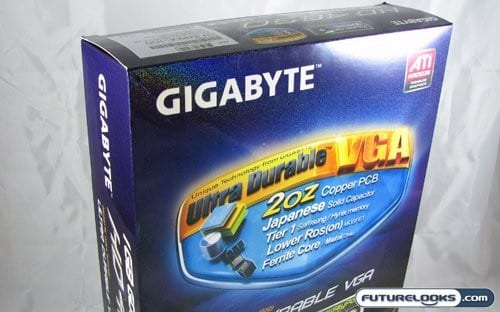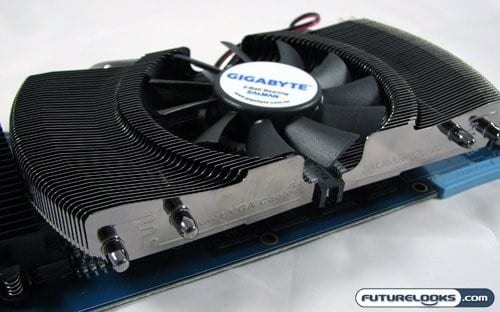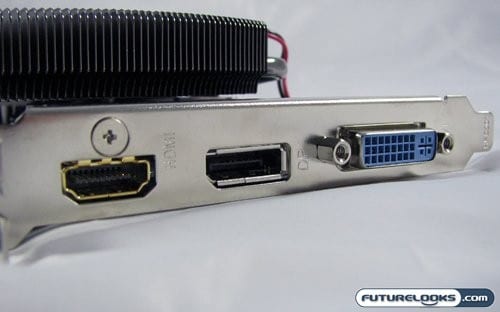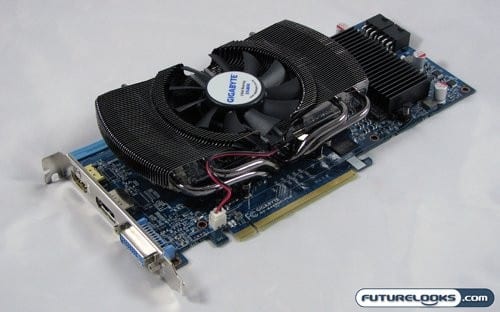
With many video card releases, a certain product progression is expected from manufacturers. The first video cards out of the gate are near replicas of the vendor’s reference design, using the same cooler and sporting the same clock speed. Then manufacturers get crafty, playing with clock speeds and adding more RAM to try to capture the performance segment of the market.
The progression then divests a little, with high end video cards getting more exotic cooling and more overclocking, and lower end parts going toward the HTPC and silent PC market. But what if those guys with their fancy quiet HTPC setups want a high performance card? Well GIGABYTE might just have the solution for them.
Introducing the GIGABYTE GV-R4890C-1GD

GIGABYTE has taken the stock Radeon HD 4890 card, changed it’s colour, and in partnership with Zalman installed a rather hardy VF 1050 VGA cooler. The idea behind this is a video card whose performance is a quiet one, making this card a great addition to any PC where low noise is a priority but performance is desired. The cooler, however, does not come in contact with the RAM and does provide no additional cooling effect.
Since this card sports the same features as any other 4890, performance definitely won’t be sacrificed. Here’s a quick peek at the features on this card:
- Powered by Radeon HD 4890 GPU
- Supports PCI Express 2.0
- Microsoft DirectX 10.1 and OpenGL 3.0 support
- Integrated with the first 1GB GDDR5 memory and 256-bit memory interface
- Supports CrossFireX™ and Avivo™HD technology
- Features Dual-link DVI-I / HDMI / Displayport
All the details for this video card can of course be found on the product home page. However, when you look at those preliminary specs you can see that this card is edging towards the HTPC market.

GIGABYTE has dropped the second DVI port in favour of HDMI and DisplayPort output. HDMI we’re all quite familiar with, but DisplayPort is a relatively new specification that is finally starting to be seen on consumer products. The card is also factory overclocked, which while not something typically seen in an HTPC or a quiet computer, it isn’t exactly unwelcome.
The Bits in the Box
For all the extra bells and whistles found on the GIGABYTE video card, the accompanying accessories pack is rather typical of what you see in most video cards these days. Still it isn’t without it’s interesting additions.
You’ll find the usual Molex-to-PCIe power adaptor, CrossFire bridge, and DVI-to-VGA convertor included. In addition to that, there was one adaptor I didn’t expect to find but hoped was there. Rounding off the accessory package is the drivers CD and manual.
The single DVI port on the back of the card precludes it from being used in a dual monitor rig, unless you have a monitor that uses HDMI or DisplayPort. With this in mind GIGABYTE included a male-to-female HDMI-to-DVI convertor; a complete reverse from what is normally found with cards sporting two DVI ports. This of course lets you use your two DVI-based LCD panels without issue.
Internal Connections
Like any other Radeon HD 4890, the R489OC uses two 6-pin PCIe connectors for extra power. The card is also the same length as a standard HD 4890, and that combined with the length of this card may cause some problems for those with smaller cases, or cases with a unique configuration.
Power stability is handled by the use of solid state Japanese capacitors. Even without any extra RAM cooling, this should give us a helping hand when we do try to overclock this card. It definitely won’t be the weakest link in the chain.
If you aren’t interested in overclocking and really just want the quietest performance rig you can manage, the R489OC supports CrossfireX like any other 4890. You can hook this card up in a dual or triple configuration without issue, and things should remain fairly quiet under even the most strenuous of gaming sessions. Bear in mind that the cooler still makes the card a dual slot solution, and you’ll need to plan placement of your expansion cards accordingly.
Time For Testing
Testing the GIGABYTE GV-R489OC-1GD Radeon HD 4890 video card consisted of installing it into my current test rig, and running a series of gaming and 3D performance based benchmarks to see how it faires. The latest current drivers from ATI were used in all tests, and the card was pitted against its vanilla Radeon HD 4890 card brother that we reviewed a while back.
Here are the rest of the test rig specs:
- AMD Phenom II X4 965 Black Edition CPU
- GIGABYTE GA-MA790FXT-UD5P AM3 790FX Motherboard
- Kingston HyperX 4GB DDR3-1600 Dual Channel Memory Kit
- GIGABYTE GV-R489-1GH-B Radeon HD 4890 Video Card
- Kingston SSDnow V-Series 128GB Solid State Hard Drive
- HighSpeed PC Top Deck Tech Station
- Lian Li MAXIMA Force Extreme PS-A650GB 650W Power Supply
- Samsung SyncMaster 2493HM 24 Inch LCD Monitor
As for actual benchmarks we pretty well focused on gaming, trying to pick the most punishing titles in a particular genre. We brought back 3DMark06 for this review, since there are still some very popular DirectX 9 based titles hanging around.
Overclocking Comes First This Time
Why am I leading off with overclocking? The answer is quite simple actually. The impetus of this video card, other then it affection for silence, is that it’s factory overclocked and cooled using a 3rd party cooler. So we should be able to push a little further, right? Not so much.
The R498OC is already running at a core speed of 900MHz, which is 50MHz higher then stock, or 6% depending on how you do the maths. The memory is bone stock, as I mentioned that in theory it can’t be run any higher due to spec and lack of any cooling. Turns out my theory was accurate.
Simply trying to use ATI’s auto-tune feature to find the best GPU and RAM speed resulted in a BSOD and reboot. Turning towards manual tweaking didn’t get me much either, as the core wouldn’t run stable at any higher speeds. Looks like quiet is this card’s only game. Still the factory overclock should get us some additional performance in our benchmarks.
Synthetic Tests
While some would argue that 3DMark06 Pro is a little too antiquated to be used in testing of modern video cards, I would say it’s at least a good place to start when you need to test DirectX 9 performance. At the very least you get some really high numbers, and who doesn’t like high numbers?
Ahem…anyhow, to test the GIGABYTE card we used the default settings for 3DMark06. This produced a 2% performance advantage for the GIGABYTE oc’d card compared to it’s stock cousin.
The performance delta in our 3DMark Vantage tests was a little wider, with between 3% and 5% being posted for each test. Though on the surface this doesn’t appear to scale well with the 6% overclock I mentioned on the GPU, you have to remember that memory is running at stock speeds and these numbers will be an aggregate of those two factors.
I think we need to turn to the real world to see what performance benefits this card might afford us.
The DX9 Benchmarks
Turning to some real world tests for the GIGABYTE GV-R489OC-1GD Radeon HD 4890 video card, we start off with Call of Duty 4. This this popular DX9 title has a sequel of sorts out, it uses the same engine. CoD4 still has a large audience of amateur and pro players. As for the game engine, it does have a fair degree of graphical complexity for a DX9 based engine.
All our tests were performed with maximum settings at the two most frequently used wide screen LCD resolutions. Even with this difference, we didn’t see a see gap in performance until we moved to the higher 1920×1200 resolution. There we saw a jump in performance of 5% when moving to the newer GIGABYTE card.
I would have liked to keep going to higher resolutions, but sadly the native and max resolution is where the benchmark and game limits itself.
Team Fortress 2 is still one of my favourite Valve games, mostly due to it’s class-based team-oriented combat. I’m a sucker for such things. Now normally it wouldn’t make an appearance in our benchmark suite, but an upgrade to the L4D engine rendered our demo unusable. TF2 still does put stress on video cards, and we did once again see a small performance gap between the two cards that scales well with the difference is spec between the vanilla card and our review unit.
DX10 Comes Up
With DirectX 10, games place a little more pressure on GPUs. This is clearly evident in our DX10 based titles. The results pulled from our benchmark of Crysis produced results so close to each other as to not really matter.
World in Conflict didn’t faire much better, posting exactly the same results in our lower resolution tests. There was a spike in performance when we cranked up the resolutions, and it once again scaled with the minor jump in GPU speed. This is good as it shows the performance of this card is slightly better then stock.
Besides a minor, very minor, bump in frame rates between the bone stock vanilla version and this card, the benefits lie in the fact that the card is extremely good at not adding to the noise levels of our test system. This is very similar to the opinion we had with the review of the totally passive GIGABYTE Silent Cell HD 4850 card: Silent, but not that deadly.
Final Thoughts and Conclusion
The GIGABYTE GV-R489OC-1GD Radeon HD 4890 video card seems to be a bucket of contradictions. It’s a performance card that is silent. It has a huge aftermarket cooler but can’t really overclock. Did I mention the silent part? Oh right, that’s the major benefit of this card.
Idle or load, this card wasn’t any louder then the ambient noise coming from our test rig. This gives the card an interesting benefit, in that it can pull double duty in a gaming rig or quiet PC. The extra ports give it a certain bit of future-proofing, and make it a tantalizing video card to insert into a home theatre PC.
I’d actually have a hard time finding anything wrong with the R489OC. GIGABYTE is pricing the card aggressively, and it’s quite versatile. It would be nice to see the RAM at least passively cooled, but at least it runs in spec. The added benefit of a factory overclock does add some performance.
Taking a quick browse at Newegg.com, we see that as of the publishing of this article the GV-R489OC-1GD is going for $209.99 USD. This is only $10 or $20 more then the most basic of Radeon HD 4890 cards, making it welcome addition to any number of different personal computer configurations.
Pros
- Low price
- Cooler both silent and efficient
- Stable factory overeclock
- Lots of output options
Cons
- RAM not cooled
- Not much more overclocking headroom
Overall Rating: 9.0 / 10.0
Love This Review? Hate This Review? Leave a Comment Below!

